Nestled along the rushing waters of the Kettle River in east-central Minnesota, Banning State Park stands as one of the state’s most spectacular yet underrated natural treasures. Located just minutes off Interstate 35 near Sandstone, this 6,237-acre wilderness sanctuary offers visitors a perfect blend of geological wonders, rich history, and outdoor adventure that makes it a must-visit destination for nature enthusiasts.
What sets Banning State Park apart from other Minnesota destinations is its dramatic sandstone gorge, carved over millennia by the powerful Kettle River. The park’s rugged landscape features towering rock formations adorned with vibrant lichens and mosses, creating an almost otherworldly atmosphere that photographers and hikers alike find irresistible. Whether you’re watching daredevil kayakers navigate the notorious rapids or exploring the remnants of a 19th-century sandstone quarry, every visit to this remarkable park offers new discoveries.
How to Get to Banning State Park
Banning State Park enjoys one of the most convenient locations of any Minnesota state park, making it easily accessible for both day trips and extended camping adventures. The park sits directly off Interstate 35, approximately 93 miles north of Minneapolis about a comfortable 1.5-hour drive from the Twin Cities metropolitan area.
From Minneapolis-St. Paul, take I-35 north to Exit 191 (Highway 23) near Sandstone. Turn east on Highway 23 and follow the signs for just two miles to reach the park entrance at 195 MN-23. The well-marked entrance is impossible to miss, and ample parking is available near the visitor center.
For those coming from Duluth, the journey south on I-35 takes about 45 minutes. Exit at the same Highway 23 interchange and head west briefly before turning into the park. The strategic location makes Banning State Park an ideal stopping point for travelers heading to or from the North Shore, offering a refreshing break from highway driving.
Public transportation options are limited, so having a personal vehicle is essential. The nearest major town is Sandstone (population 2,800), which provides basic services including gas stations, restaurants, and a small grocery store. For visitors arriving by air, the closest commercial airport is Minneapolis-St. Paul International Airport, approximately 100 miles south.

History and Culture of Banning State Park
The story of Banning State Park is intrinsically linked to one of Minnesota’s most significant industrial enterprises and natural disasters. The park’s name honors William L. Banning, a visionary businessman who established the Banning Sandstone Quarry in the 1890s, transforming this remote wilderness into a bustling industrial center.
The quarry operation began shortly after the devastating Hinckley Forest Fire of 1894, one of the deadliest wildfires in American history. The fire swept through over 400 square miles of pine forest, killing more than 400 people and destroying entire communities. In the fire’s aftermath, the exposed sandstone formations revealed high-quality building stone that would become highly prized throughout the Midwest.
Banning’s quarry employed hundreds of workers who lived in a company town complete with boarding houses, a general store, and even a baseball team. The distinctive Kettle River sandstone was shipped via railroad to construct prominent buildings throughout Minnesota, Wisconsin, and beyond. Notable structures built with Banning sandstone include portions of the Minnesota State Capitol and several universities.
The quarry operated until the early 1900s, when changing building preferences and economic factors led to its closure. Nature gradually reclaimed the industrial site, but remnants of this fascinating chapter remain visible throughout the park. Visitors can explore the Banning State Park trails that wind past quarry ruins, including massive cut stone blocks, foundation remnants, and interpretive signs that bring this industrial heritage to life.
The area officially became a state park in 1963, preserving both its natural beauty and historical significance for future generations. Today’s visitors can walk the same paths where quarry workers once labored, creating a tangible connection to Minnesota’s industrial past while enjoying the restored natural environment.
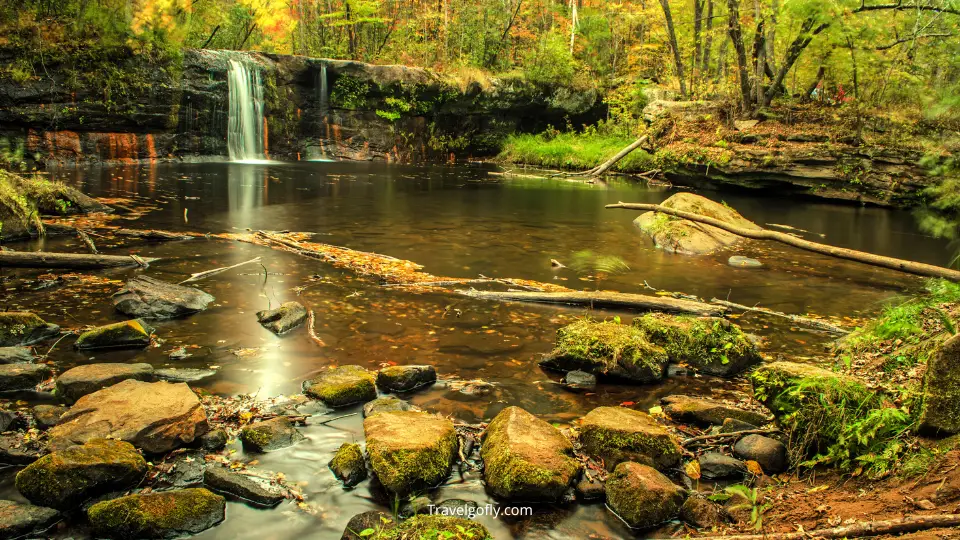
Best Things to Do at Banning State Park
Banning State Park offers an impressive array of activities that cater to adventurers of all skill levels and interests. The park’s diverse landscape and well-maintained facilities ensure that every visitor finds something memorable to experience.
Top Hiking Trails and Scenic Overlooks
The park features over 17 miles of Banning State Park trails that showcase the area’s most spectacular natural features. The Quarry Loop Trail serves as the park’s signature hike, offering a relatively easy 1.5-mile journey past the historic sandstone quarry ruins. This self-guided interpretive trail features numerous informational signs that detail both the area’s geological formation and industrial history.
For those seeking more challenging terrain, the River Trail follows the Kettle River for several miles, providing access to dramatic overlooks and secluded spots perfect for photography or quiet contemplation. The trail passes through diverse ecosystems, from dense hardwood forests to open meadows where wildflowers bloom in spectacular displays during late spring and summer.
Don’t miss the Wolf Creek Falls Trail, a moderate hike that leads to one of the park’s most photographed features. The waterfall cascades over layered sandstone formations, creating a scene that’s particularly stunning during spring snowmelt or after heavy rains.
Whitewater Rafting and Kayaking on the Kettle River
Banning State Park has earned a reputation as one of Minnesota’s premier whitewater destinations. The Kettle River features several challenging rapids with memorable names like Blueberry Slide, Mother’s Delight, Dragon’s Tooth, and Hell’s Gate. These rapids attract experienced kayakers and canoeists from across the Midwest, particularly during spring when snowmelt creates optimal water levels.
The park provides excellent viewing areas for spectators who want to watch the aquatic acrobatics without getting wet. The Kettle River Rapids Viewing Area offers safe vantage points where families can observe skilled paddlers navigating the turbulent waters while enjoying a picnic lunch.
Fishing, Canoeing, and River Adventures
The Kettle River and several smaller streams within Banning State Park offer excellent fishing opportunities. Anglers can expect to find smallmouth bass, northern pike, and various panfish species. The rocky pools below rapids often hold surprisingly large fish, making them favorite spots for experienced local anglers.
The park also features several designated river access points for those wanting to launch canoes or kayaks for gentler floating experiences. During summer months when water levels are lower, tubing becomes a popular family activity on calmer river sections.
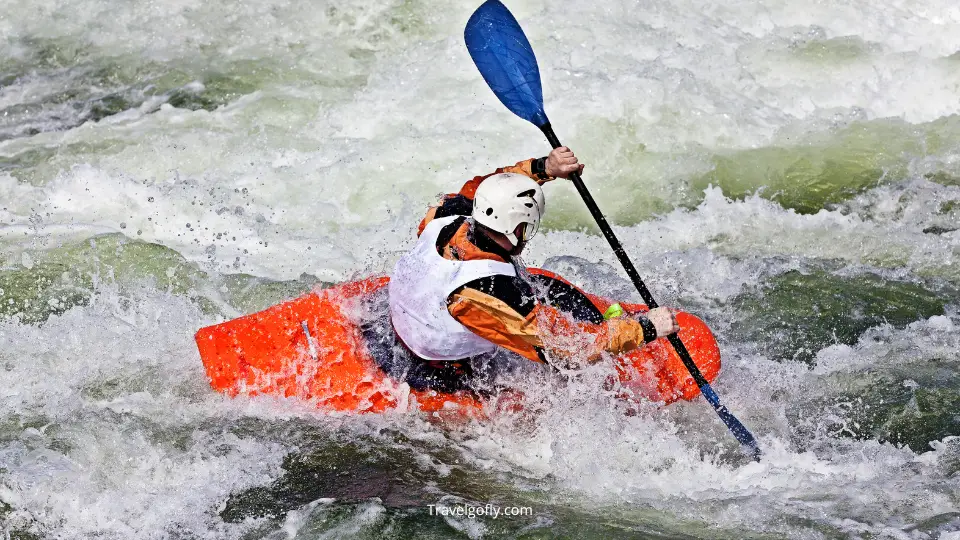
Family Activities and Winter Fun at Banning State Park
Banning State Park excels at providing activities that bring families together. The park’s picnic areas feature tables, grills, and playground equipment in scenic settings overlooking the river. The group picnic shelter can be reserved for larger gatherings, making it popular for family reunions and community events.
During winter months, the park transforms into a cross-country skiing paradise. Over 6 miles of groomed ski trails wind through snow-covered forests and along the frozen river, offering both novice and experienced skiers opportunities to explore the park’s winter beauty. The park also maintains snowmobile trails that connect to larger regional trail systems.
Camping and Lodging at Banning State Park
Banning State Park Campground: Sites and Reservations
The Banning State Park campground provides an excellent base for exploring all the park has to offer. The facility features 34 semi-modern campsites that accommodate both tent camping and RVs up to 50 feet in length. Each campsite includes a picnic table, fire ring, and access to nearby restrooms and shower facilities.
The Banning State Park campground map shows sites arranged in two loops, with many offering privacy through natural vegetation screening. Sites 1-15 are particularly popular among tent campers due to their proximity to hiking trails and relative seclusion from RV traffic. Sites 20-34 can better accommodate larger recreational vehicles and feature electrical hookups.
Banning State Park camping reservations can be made up to 120 days in advance through the Minnesota State Parks reservation system. Peak season (May through September) fills quickly, especially on weekends, so early booking is strongly recommended. Reservation fees are $8 online or $10 by phone, with camping fees starting at approximately $25 per night for basic sites.
| Campsite No. | Hookup Type | Max RV Length | Features & Proximity |
|---|---|---|---|
| 1–5 | None (Tent Sites) | Up to 30 ft | Near trailhead and restroom area |
| 6–10 | Electric (30 Amp) | Up to 45 ft | Short walk to showers and picnic area |
| 11–15 | None (Secluded) | Up to 25 ft | Private sites surrounded by trees |
| 16–20 | Electric (30 Amp) | Up to 50 ft | Easy access to dump station |
| 21–25 | Electric (50 Amp) | Up to 50 ft | Near playground and main parking lot |
| 26–30 | None | Up to 35 ft | Close to river access and hiking trails |
| 31–34 | Electric (30 Amp) | Up to 40 ft | Short distance from visitor center |
Nearby Hotels and Alternative Lodging Options
While the park doesn’t offer cabins or lodges, several excellent lodging alternatives exist nearby. The historic Sandstone Inn in downtown Sandstone provides comfortable rooms with easy access to restaurants and shops, making it perfect for visitors who prefer indoor accommodations while still enjoying park activities during the day.
For those seeking a more rustic experience, several private campgrounds in the area offer amenities like full hookups, laundry facilities, and camp stores. The Banning RV Park (separate from the state park) provides luxury camping options with rental trailers and enhanced amenities.
Visitor Information for Banning State Park
Park Hours, Entrance Fees, and Permits
Banning State Park maintains year-round accessibility with gates open daily from 8:00 AM to 10:00 PM. All vehicles entering the park require a current Minnesota State Parks permit, which can be purchased online in advance or at the park office upon arrival. Annual permits offer the best value for frequent visitors, while daily permits are available for occasional visits.
Current permit fees are:
- Annual permit: $35 per vehicle
- Daily permit: $7 per vehicle
- Annual permit for Minnesota residents 65+: $26
- Annual permit for disabled veterans: Free
Park Facilities, Amenities, and Accessibility
The park’s visitor center serves as an excellent starting point for any visit. Staff members provide current trail conditions, weather updates, and recommendations tailored to visitor interests and abilities. The center also features educational displays about the park’s geology, history, and wildlife.
Modern restroom facilities with flush toilets and hot showers are strategically located throughout the park, including near the campground, day-use areas, and major trailheads. Drinking water is available at multiple locations, though visitors should always carry additional water during extended hikes.
The park maintains several large parking areas that accommodate both cars and recreational vehicles. The main parking area near the visitor center provides easy access to most trails and facilities, while additional lots near specific attractions reduce walking distances to popular destinations like Wolf Creek Falls.
Park Rules, Pets, and Safety Guidelines
Banning State Park operates under standard Minnesota State Parks regulations designed to protect both visitors and natural resources. Pets are welcome throughout the park but must remain on leashes no longer than six feet at all times. Pet owners are responsible for cleaning up after their animals and ensuring they don’t disturb wildlife or other visitors.
Campfires are permitted only in designated fire rings and must be completely extinguished before leaving the area. During periods of high fire danger, restrictions may be implemented current fire conditions are always posted at the park office and major bulletin boards.
Alcohol consumption is prohibited in all Minnesota state parks, and quiet hours in the campground are enforced from 10:00 PM to 8:00 AM. These regulations help ensure that all visitors can enjoy peaceful experiences in the natural environment.
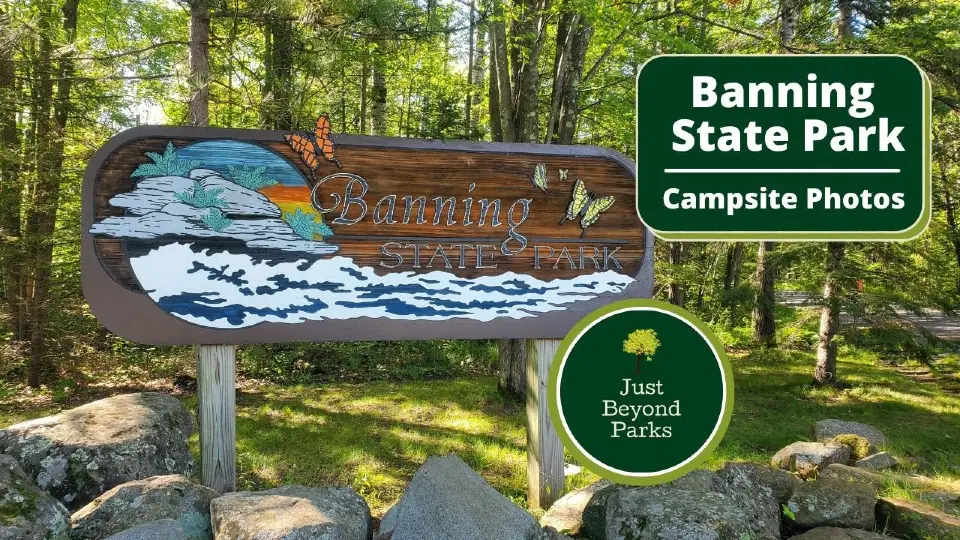
Insider Tips for Visiting Banning State Park
Best Times to Visit Banning State Park
While Banning State Park offers year-round beauty, timing your visit can significantly enhance your experience. Late April through early May provides the most dramatic whitewater action as spring snowmelt swells the Kettle River to its most impressive levels. This is prime time for watching skilled kayakers tackle the challenging rapids, though hiking trails may still have muddy conditions.
Mid-May through June offers the perfect balance of manageable water levels, comfortable temperatures, and spring wildflower displays. The forest canopy hasn’t fully developed, allowing more sunlight to reach forest floors where trilliums, bloodroot, and other ephemeral flowers create magical displays.
September and early October present arguably the park’s most photogenic period. The hardwood forests explode in brilliant reds, oranges, and yellows that contrast beautifully with the gray sandstone formations. Cooler temperatures make hiking more comfortable, and decreased insect activity enhances outdoor enjoyment.
Winter visits offer a completely different but equally rewarding experience. Snow-covered sandstone formations create striking black-and-white landscapes, while cross-country skiing provides access to areas that are difficult to reach during other seasons.
What to Pack for Your Banning State Park Trip
Experienced Banning State Park visitors recommend packing layers regardless of season, as temperatures can vary significantly between sunny exposed areas and shaded river valleys. Sturdy hiking boots with good ankle support are essential, particularly on rocky sections of trail where loose sandstone can create unstable footing.
Bring more water than you think you’ll need the park’s rugged terrain and dry climate can lead to faster dehydration than expected. While water is available at facilities, having personal supplies ensures you can explore remote areas without concern.
Photography enthusiasts should pack extra batteries and memory cards. The park’s dramatic lighting conditions, especially during golden hour, create countless photo opportunities that can quickly fill storage space.
Hidden Gems and Secret Spots in the Park
The Log Creek Arches represent one of Banning State Park’s best-kept secrets. This natural sandstone formation requires a moderate off-trail hike but rewards visitors with stunning geological features that few people ever see. Local park staff can provide directions to visitors who demonstrate hiking experience and respect for natural resources.
Robinson’s Ice Cave offers another hidden gem, particularly fascinating during winter when ice formations create ethereal displays. The cave stays cool even during summer, making it a welcome respite on hot days.
For the best Banning State Park photos, visit the main rapids viewing area during late afternoon when low-angle sunlight illuminates the sandstone cliffs and creates dramatic shadows. The contrast between rushing white water and warm-toned rock creates images that capture the park’s essential character.
Early morning visits often provide wildlife viewing opportunities that later arrivals miss. White-tailed deer, wild turkeys, and various bird species are most active during dawn hours when the park is quiet and peaceful.
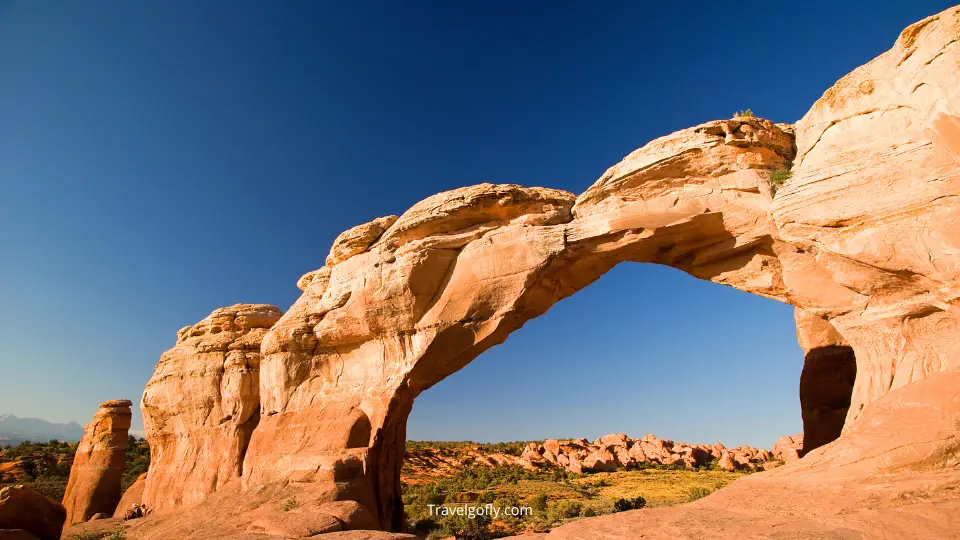
Local Dining and Supply Options Near Banning State Park
While Banning State Park offers basic camping supplies at the visitor center, serious provisioning should be done in nearby Sandstone. The Sandstone Market provides groceries, ice, camping supplies, and local advice from knowledgeable staff who understand visitor needs.
For memorable dining experiences, the Northern Rail Traincar Restaurant in Sandstone occupies an authentic railroad car and serves hearty meals that satisfy hungry hikers. Their breakfast menu is particularly popular among early-rising campers preparing for full days of outdoor adventure.
Frequently Asked Questions About Banning State Park
Is Banning State Park good for beginners?
Banning State Park offers excellent opportunities for hiking beginners, particularly on the Quarry Loop Trail and portions of the River Trail. These well-maintained paths feature gentle grades and clear signage that help newcomers build confidence while exploring beautiful scenery. The park’s compact size means that even longer hikes return to familiar areas, reducing concerns about getting lost.
What’s the difference between Banning State Park and other Minnesota parks?
Banning State Park stands apart due to its unique combination of dramatic sandstone geology, industrial history, and whitewater features. While many Minnesota parks focus on lake environments or prairie ecosystems, Banning showcases the power of moving water to carve spectacular landscapes. The visible quarry ruins also provide tangible connections to human history that many other parks lack.
Can you swim in the Kettle River at Banning State Park?
While swimming isn’t prohibited, the Kettle River’s swift currents, rocky bottom, and cold temperatures make it unsuitable for casual swimming. The park doesn’t maintain designated swimming areas, and visitors should exercise extreme caution near water. Wading in shallow areas during low water periods can be refreshing, but always use appropriate judgment regarding water safety.
Are the Banning State Park trails suitable for mountain biking?
Banning State Park trails are designated for hiking only and mountain biking is not permitted. The rocky terrain, narrow pathways, and high pedestrian use make these trails inappropriate for cycling. However, nearby state forests and regional trail systems offer excellent mountain biking opportunities within a short drive.
What wildlife might I see at Banning State Park?
The park supports diverse wildlife populations including white-tailed deer, black bears, wild turkeys, pileated woodpeckers, and various songbird species. River environments attract great blue herons, kingfishers, and occasionally bald eagles. Small mammals like chipmunks, squirrels, and raccoons are commonly observed, while more elusive species like bobcats and timber wolves occasionally pass through the area.
How far is Banning State Park from other attractions?
Banning State Park enjoys an excellent location for exploring east-central Minnesota. The park sits approximately 45 minutes from Jay Cooke State Park near Duluth, creating opportunities for multi-park adventures. The historic town of Hinckley with its fire museum lies just 20 minutes south, while the St. Croix National Scenic Riverway is within an hour’s drive to the southeast.
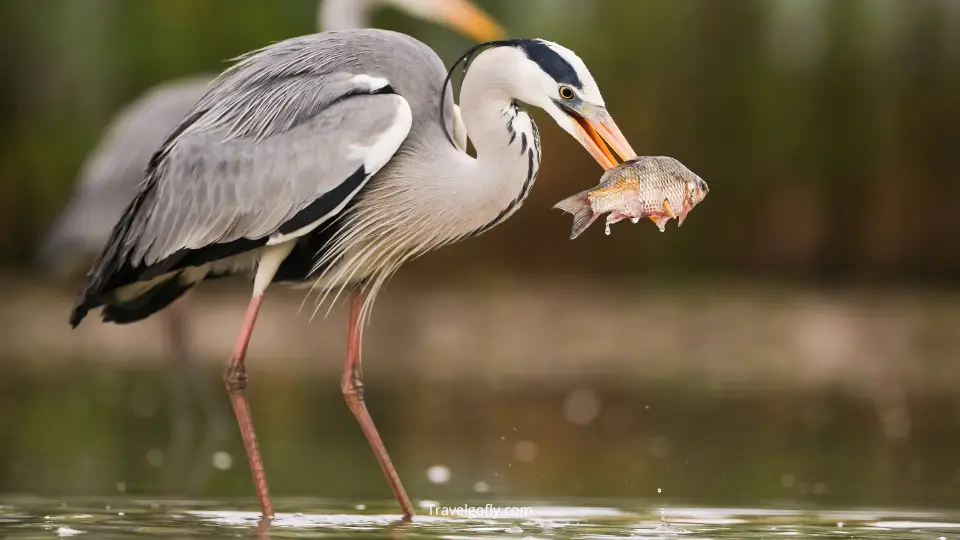
Plan Your Visit to Banning State Park, Minnesota
Banning State Park represents Minnesota’s natural diversity at its finest, combining geological wonders, rich history, and outdoor recreation into an unforgettable destination. Whether you’re planning a weekend Banning State Park camping trip, a day hike to explore the Banning State Park trails, or simply want to witness the power of whitewater rapids, this remarkable park delivers experiences that create lasting memories.
The park’s convenient location makes it an ideal addition to any Minnesota travel itinerary, while its diverse attractions ensure that repeat visits reveal new discoveries. From the thundering rapids of spring to the peaceful beauty of snow-covered winter landscapes, every season offers its own rewards for visitors willing to explore this sandstone sanctuary.
Start planning your visit today by checking the Minnesota DNR website for current conditions and making campground reservations well in advance. Don’t forget to obtain your state parks permit and consider combining your Banning State Park adventure with visits to nearby attractions for a comprehensive Minnesota outdoor experience.
Consider exploring other Minnesota state parks in the region, such as Moose Lake State Park or Wild River State Park, to extend your natural adventure. Each park offers unique features that complement the Banning State Park experience while showcasing different aspects of Minnesota’s remarkable natural heritage.
Have you visited Banning State Park before, or are you planning your first adventure to this sandstone wonderland? Share your experiences, questions, or travel plans in the comments below your insights might help fellow travelers discover their own perfect Minnesota outdoor adventure!
